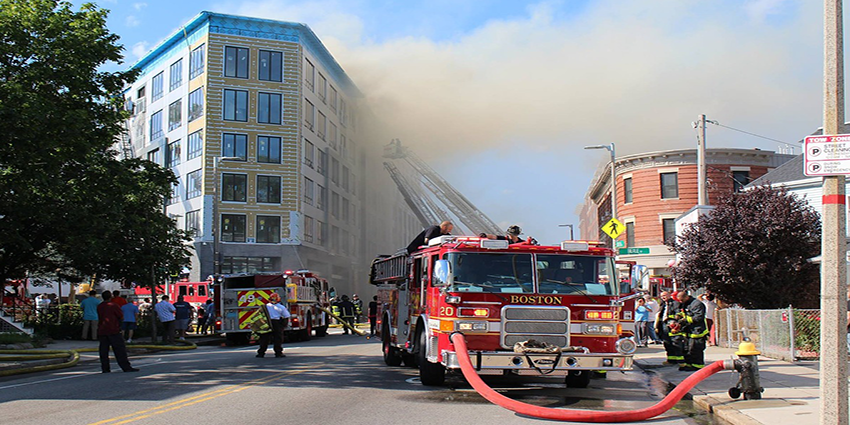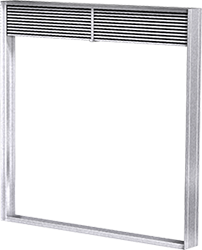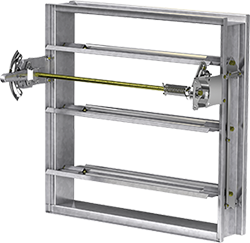
 |
| Figure 1 - Purpose of a Fire Damper |
Fire Damper Construction Types
There are two common construction types of fire dampers: curtain and multi-blade. Both styles are manufactured using either galvanized or stainless steel, and both utilize a fusible link to hold the damper blades open until it reaches an elevated temperature (minimum of 165°F). The link material melts at that point and separates, allowing the damper to slam closed. |
| Figure 2 -Curtain Style Fire Damper |
Curtain-style blades (Figure 2) are accordion-like stacks folded and held open at the top of the damper to allow airflow during normal HVAC system operation. The blade stack closes, activated by an attached spring, the force of gravity or a combination of a spring and gravity once the heat reaches the melting point of the fusible link.
A multi-blade style fire damper (Figure 3) uses individual blades, spaced apart and connected with a common linkage allowing the blades to rotate open or close in unison. The linkage connects to a spring-wound shaft held open with the fusible link. When the link separates at elevated temperatures, the shaft spring engages, forcing the damper blades to close. A multi-blade style fire damper also offers an advantage with its ability to adjust the position of the blades manually and perform the same function as a balancing damper in an HVAC system.
 |
| Figure 3 -Multi-Blade Style Fire Damper |
Meeting UL Test Requirements
All UL certified fire damper models are required to undergo a fire endurance and hose stream test to determine if the product will effectively prevent the spread of flames and preserve the fire-resistance rating of the applicable construction element. Fire dampers carry a fire-resistance rating of 1 ½ or 3 hours, equating to the length of time exposed to the fire test. A 1 ½ hour rated fire damper may be installed into walls, floors, or partitions having a fire-resistance rating of less than 3 hours, while any assembly with a rating of 3 hours or more requires a 3 hour rated fire damper. Immediately after the conclusion of the fire test, the damper is subjected to a high-pressure hose stream test. The hose stream test provides an extreme structural and thermal shock that ensures fire dampers are structurally strong enough to withstand the rigors of the most severe fire conditions.Another UL 555 test requirement for fire dampers is the cycling test. To pass this test, a damper sample must be opened manually and allowed to close completely 250 times, simulating more usage than the product would see over the lifecycle of the building. This demonstrates that the damper will still function effectively after the wear and tear of multiple closures.
All fire dampers must pass a salt-spray exposure test. In this test, a damper sample is exposed to salt spray in a test chamber for 120 hours. The damper must close completely (and latch automatically if a latch is provided) after the exposure. This test demonstrates a damper’s ability to operate after a more severe fouling than the damper is likely to experience during its intended application.
Static and Dynamic Fire-Rated Dampers
There are two types of UL 555 rated fire dampers:
- Static rated fire dampers have no airflow closure rating. These can only be applied in HVAC systems designed to shut down automatically in the event of a fire.
- Dynamic rated fire dampers close while the HVAC system is running, and should be selected to operate against the airflow conditions seen in the application. These carry an airflow velocity rating (fpm) and a pressure differential rating (in. wg).
Dynamic-rated products require UL 555 dynamic closure testing to develop ratings for velocity and pressure. The dynamic closure test evaluates the ability of a fire damper to close under airflow. Airflow conditions for this test are established by setting the velocity with the damper blades in the fully open position, and setting the pressure with the damper blades fully closed. The damper is then set to the open position and airflow is applied. The damper is tested to demonstrate complete closure against the prescribed airflow three times at ambient air conditions. It is then tested a fourth time with the air heated such that the damper’s fusible link melts and causes the damper to close.
Dynamic closure velocity ratings begin at a minimum rating of 2000 feet per minute (fpm) with optional higher ratings in increments of 1000 fpm above that. The higher rating option is for dampers testing at a higher performance level. Similarly, dynamic closure pressure ratings begin at 4 in. wg, with optional higher ratings in increments of 2 in. wg, also for testing at higher performance levels. Another important aspect is a standard safety factor is applied during testing. UL 555 mandates damper samples test at airflow conditions that are at least 400 fpm and 0.5 in. wg. higher than the desired ratings. This safety factor ensures dampers perform as intended under the rated airflow conditions when installing in the field.
More information on fire damper installation and options will appear in a coming post. Be sure to watch for it. Until then, you can find out more about the various fire damper types here.
Dampers


from